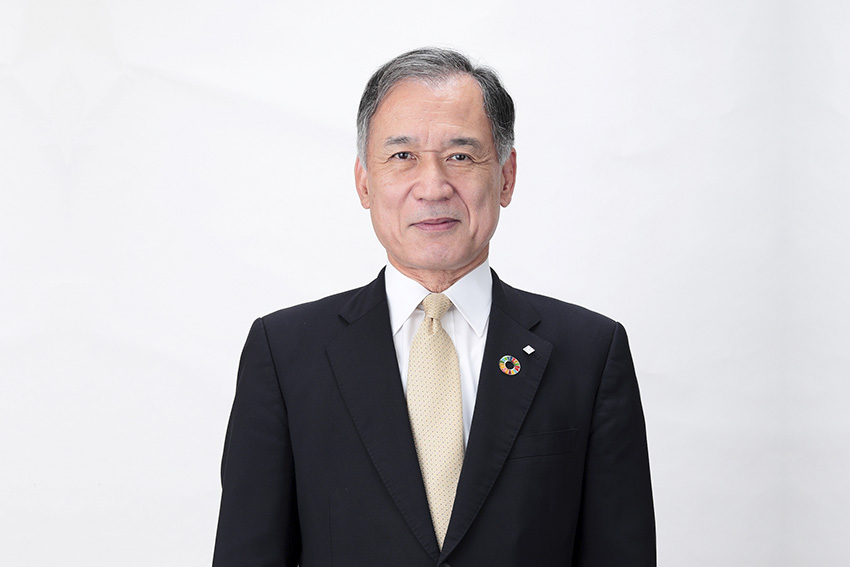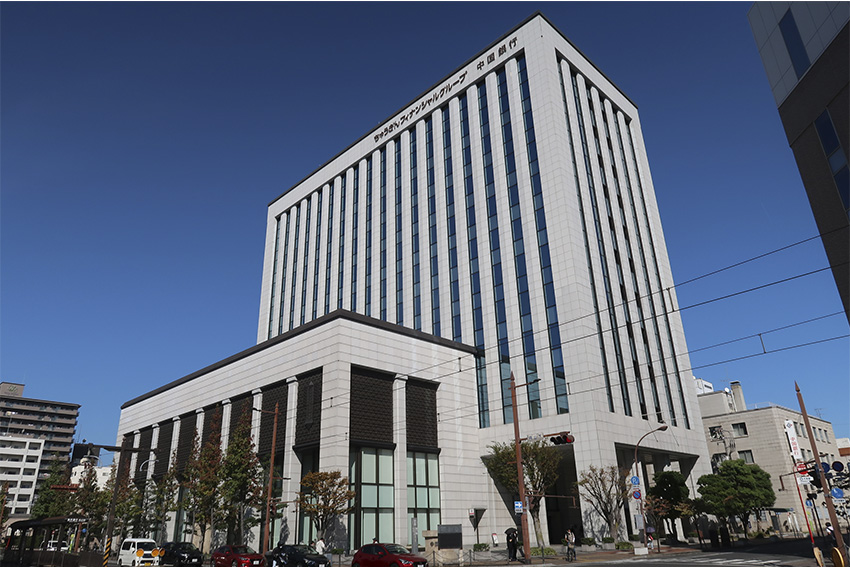By growing with its customers, employees, and local community, Chugin Financial Group is building a bright financial future we can all be proud of.

Could you give us a quick introduction to your company?
The Chugoku Bank, Ltd was established back in 1930. The area we are in is categorized into three regions: Bitchū, Bizen, and Bingo. The Bingo area focuses on East-Hiroshima, which includes Fukuyama and Onomichi. The businesses and culture all really come from the same area, meaning we have a broad range of business areas. What I’m trying to tell you is that although we are a regional bank, we focus on a very wide area that isn’t solely focused on a single prefecture. As the president of a regional bank, I understand our role to contribute to the revitalization of the region.
Okayama has evolved into a logistics hub due to its easy access to major cities. I believe there are many new business opportunities in Japan, but the situation right now is that major cities like Tokyo, Osaka, are growing, centralizing the population, whereas regional cities are shrinking in population. We want to reverse this flow, and we are constantly thinking about how to do so. This is the driving mission of our company. Japan itself is a small island, so by restricting and centralizing the population around certain areas, you create risk for business continuity. This is especially true for Japan since the country is prone to natural disasters. The quality of life will also diminish if you concentrate too many people in a small area. In order to have more sustainable growth, it is important to revitalize regional areas.

When you look at the revitalization of Japanese regions, we are starting to see some successful cases in recent years. Kyushu has been a success, and Fukuoka is growing in population because it has become a hub for tourism. Kumamoto is another great case, and through heavy government support, the region was able to attract TSMC, creating an influx of workers. What do you believe are the advantages of Okayama?
The greater Okayama area has high potential in many areas. First of all, climate-wise, the area is very warm and comfortable. In terms of transportation and logistics, it is very convenient, and there are new possibilities for agricultural and environmental businesses. In the surrounding area, there is a heavy concentration of heavy industries and factories, so taking measures is an immediate concern in terms of CO2 reduction and carbon neutrality. Chugin Financial Group is actively leading the way in decarbonization. The combination of DX technologies we employ is becoming a model case. With the shortage of drivers and the rising costs of logistics, it has become more of a strategy for companies to locate themselves in transportation hubs, and Okayama is the best possible option for these companies. Okayama is also known as a less risky area in terms of earthquakes, and fortunately, there are no local active bridges. The ground is considered very robust, making it a good location for data centers. Other banks and companies are now setting up their data centers in the local area. Okayama is known for manufacturing, and many major companies like Mitsubishi Motors and JFE Holdings have their locations in the area along with many of their subsidiaries and related companies. There are also many SMEs with their own unique technologies here. We are very supportive of startup businesses and changes in the business operations of existing companies. By collaborating with academia and other companies, we can build great growth for the region step-by-step.
Your company has initiatives such as the Okayama Innovation Project, among many others. These are designed to nurture startups and create entrepreneurs. Additionally, programs such as the Chugin Infinity Fund show that Chugin is committed to helping businesses and the local community thrive. Why was it important for Chugin Financial Group to consider Okayama and the surrounding areas when designing its mid-term objectives? What is the importance of nurturing startups in Okayama, and how does that add value to your company?
Many companies may find it hard to adapt to the ever-changing environment, so with new startups, they have a more flexible mindset. Finding potential next-generation businesses.
Okayama University is an academic institution with which we collaborate, and it is known as a pioneer in the SDGs space. In fact, the former president of the university was invited to the United Nations to give a speech on the proactiveness of Okayama University and the Okayama area in the promotion of SDGs as a model case. Chugin Financial Group is part of this big circle. About three years ago, we established a department dedicated to the promotion of SDGs.
Last year, Okayama University made major organizational reforms to its engineering department, expanding the scope of engineering within the faculty. This expansion included further startup promotion. Now, the engineering department is recruiting professors from overseas and strongly supports startups among its students. Chugin Financial Group and other companies are supporting these seeds of innovation with the hope that they one day grow into mighty oak trees for the Okayama area. I visited Silicon Valley this year to learn about how the startup environment was created. By learning lessons from these cases, I want to create a startup hub area within Okayama.
What were some of the main takeaways from your US trip that can apply to Okayama?
The biggest takeaway I had was the cultural business mindset they have there. In Silicon Valley, failure is considered an experience or a reward. The more failures you have, the more trust others have in you. In Japan, it is the opposite, and just a single failure can hang on a person for the rest of their life. It is important that financial institutions like ours change the mindset of Japanese people so that they are no longer scared to take risks or fail at something. However, just copying Silicon Valley won’t necessarily lead to success, and a better approach would be to have a Japanese interpretation of these practices to help Japanese companies grow. Okayama City has an established location for business matching, so those individuals with startups can have meetings with other companies and financial institutions. There is also a business contest held every year since 2017. It is interesting to see how participants are changing to match the big changes in society. After the contest, there is usually a networking session where those who compete can meet others who are like-minded.
In the mid-to-long term, these activities are very important in understanding the mindset of emerging partners. We can then take that information and provide the required new services. By having successful cases one by one, we are able to enlarge the circle of influence, involving regional businesses on a wider scale. All together, we can raise and revitalize Japan as a whole. There is a small town called Nishiawakura, and it was designated as the first decarbonization leading case. The Japanese government is selecting 100 localities as pioneering leading cases for decarbonization, and among the first chosen there were 26 towns and cities. This was a unique case, actually, where we, the local bank, worked together with the local government to apply this decarbonization scheme. We were also involved in the secondary application process. Rumors spread very quickly, attributing it to financial institutions like ours being involved in the screening process.
This area is quite interesting, and about ten years ago, it went through extreme depopulation. Honestly speaking, it was on the verge of extinction. However, a person who graduated from Kyoto University gathered his friends at an old abandoned school and started living there to do new startup activities. This has brought many of the young generation to Nishiawakura. Now, it is considered one of the more avid towns in Okayama. We, as a financial institution, have helped them apply decarbonization.

There seem to be four main goals you are aiming for: the promotion of more industrial activity, Okayama as a logistics center, the region becoming a case study for SDGs, and the development of an entrepreneurial startup ecosystem. Taking those four big axes you’ve identified, how important do you think it will be for Okayama to attract foreign investors, corporations, and funds to achieve your goals?
As for industrialization, there are many existing manufacturing factories, so decarbonizing these facilities has become very important. Rather than focusing on further growth of the existing industry, it would be a shift to more environmentally sound business operations as well as the evolution of new businesses that focus on the environment. As for overseas investment and companies, we are very welcoming. We strongly want to promote the positive aspects of Okayama. The governor of Okayama is very proactive in going overseas to invite overseas investments into Okayama. Our company also has branches overseas in Singapore and Hong Kong, which are vital as a point of contact with potential foreign investors. Having said that, it is also very important to be prepared to welcome foreign investors. We are in the process of creating a more comprehensive welcoming ground for those foreign investors.
In this area, there are many companies that traditionally go overseas, and before, they were mainly in China. Now, this has expanded to other Asian regions. I am actually the vice president of the Chugoku Area Economic Committee. I’ve often talked about going beyond Tokyo and just focusing directly on overseas.
Your company traces its roots back to 1930 when Chugoku Bank was founded. You established a holding company two years ago, part of a ten-year strategic plan in fostering long-term growth and innovation. What has been the one main advantage that the transition to a holding structure has yielded for your company?
When we formulated our ten-year plan, converting ourselves into a holding structure wasn’t within the vision. The ten-year plan was framed during low interest rate timing, right before the Bank of Japan imposed a negative interest rate policy. There was more concern about how we, as a financial bank, would go through this changing situation. The government has pushed the rhetoric that there would be a relaxing of regulations for financial institutions, but that did not happen until just two years ago. This amendment in November 2022 led to our decision to change ourselves to a holding company so that we can operate more freely in various areas.
I’ve been the president for five years now, and for that entire duration, I have been expanding the scope of our business, providing more comprehensive solutions to clients, which is only possible thanks to the shift to a holding company. The biggest positive impact of this change in structure is the freedom outside the pyramid of banks, and essentially, this allows us to have clearer horizontal levels of communication. Each subsidiary company is now independent, giving them freedom and responsibility for themselves. Within the holding group, we are able to exchange personnel. With all of these activities enforced, profitability has gone up, especially with our leasing and security companies. With all this being said, there are still improvements that we can make.
The biggest synergy we can see is the sort of inter-human exchange that allows us to fully leverage the sales capabilities of our bank across multiple branches. Using this across the group has resulted in sales being promoted overall. This offers customers a comprehensive service, and while there are some things I cannot share today, synergistic effects are good.
Over the past years, you have opened four new subsidiaries. While you offer traditional banking and financial functions, you also cover investments, advisory, securities, and asset management services. We’ve also seen that in recent times, you’ve moved into non-financial sectors, including subsidiaries for renewable energy, HR, and consulting. Looking at the future, are there any new services or businesses that you’ll be looking to open, or are you going to look to focus on strengthening the ones you already have?
We want to strengthen our non-financial operations because there is a strong interconnectivity between our financial business and our non-financial businesses. Traditionally, banks have provided loans to companies that have a plan to create new businesses. We want to be with those companies from the beginning stages, all together elevating the idea of the business and streamlining processes. Rather than making companies choose the financial institute they go with, we can provide them comprehensive support from inception.
The company has evolved into a holding company, and with that transition, we are able to provide human resources in addition to services, information, and financial support. Now, we want to take all of those elements to the next step.
What makes financial institutions unique is the information gathered from local companies and local governments. On a daily basis, conversations are held about current issues and challenges. All of this data has been accumulated, so I can see our company playing a matchmaker role for M&As. We want to find more ways to utilize the information that we have meticulously gathered.
Imagine that we come back in 2030 and have this interview all over again. What goals or dreams do you hope to achieve by the time we come back for that new interview?
As our corporate Principle states, our goal is “Create with our community, customers and employees a rich future that we can all share”. The mission is to have the locality prosper and flourish together with region and our customers. Achieving this prosperity together is our ultimate goal.
For more information, please visit their website at: https://www.chugin-fg.co.jp/en/
0 COMMENTS